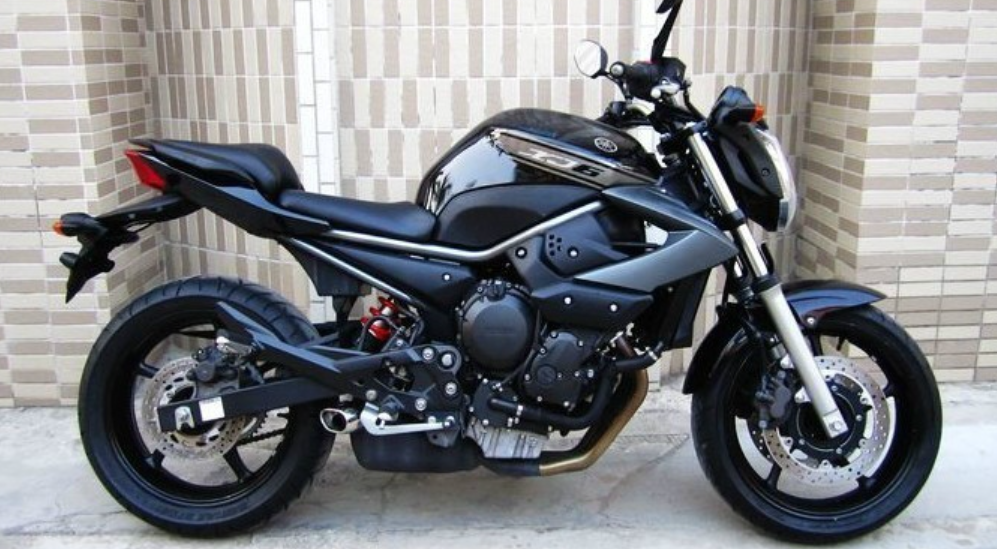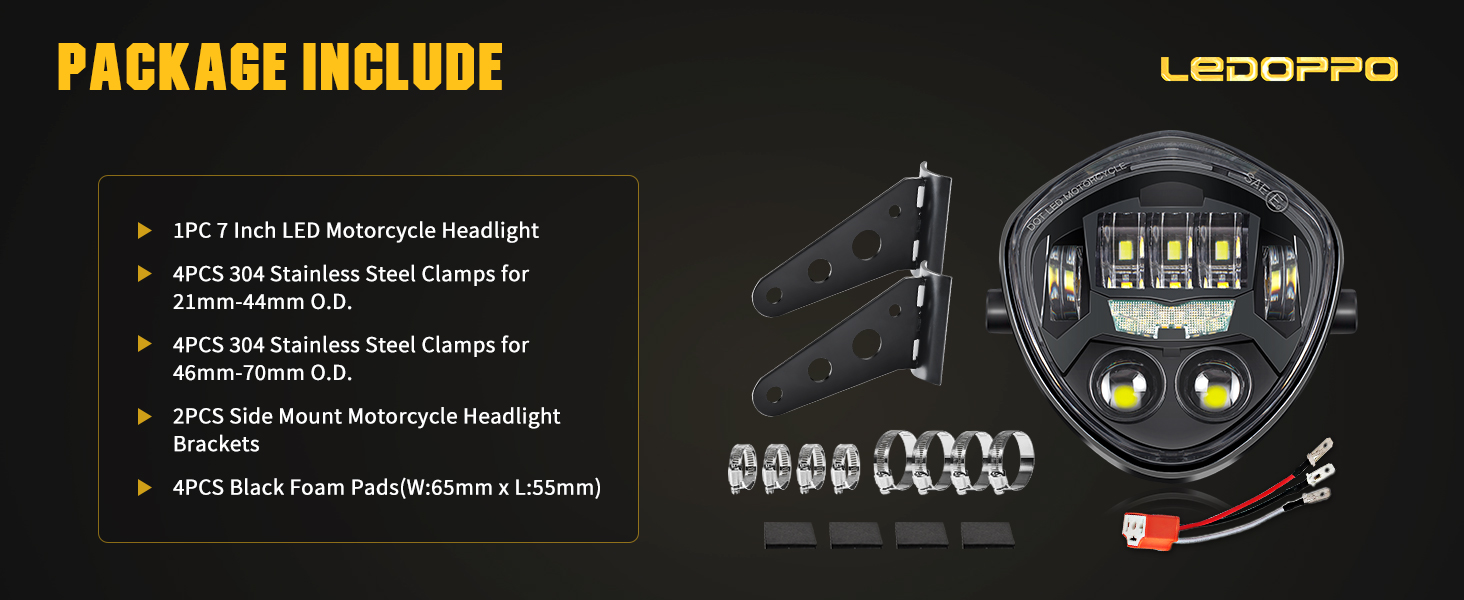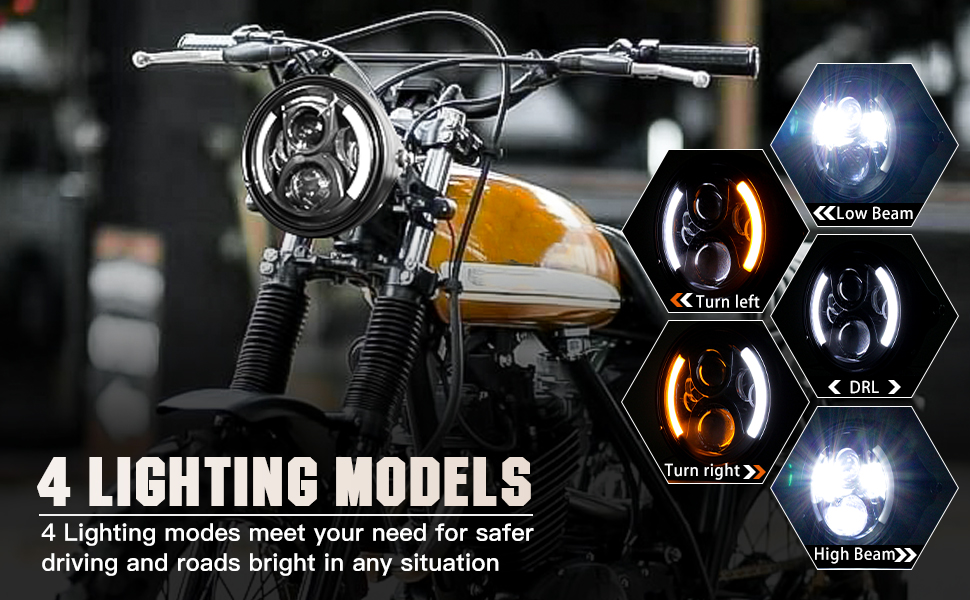Why Beam Pattern Is More Important Than Brightness? - A Discussion on Motorcycle Headlight Compliance and Safety
- 1. The Basic Functions of Motorcycle Headlights
- 2. The Relationship Between Brightness and Beam Pattern
- 2.1 The Role of Brightness
- 2.2 The Role of Beam Pattern
- 3. Why Beam Pattern Is More Important Than Brightness
- 3.1 Beam Pattern Directly Affects Road Safety
- 3.2 Beam Pattern Helps Reduce Glare
- 3.3 Compliance and Regulatory Requirements
- 3.4 Brightness Is Not the Only Metric
- 4. Challenges and Innovations in Motorcycle Headlight Design
- 4.1 Smart Headlight Technology
- 4.2 LED and Laser Lighting Technology
- 4.3 Compliance and Global Challenges
- 5. BLIAUTO’s Contribution
- 6. Frequently Asked Questions
- 7. Conclusion
Motorcycle headlights are one of the most crucial safety components on any motorcycle. Whether riding during the day or night, the effectiveness of the motorcycle’s headlight directly impacts the rider's visibility, reaction time, and their interaction with other vehicles on the road. However, many riders and manufacturers tend to focus more on brightness when choosing headlights, often overlooking the importance of the beam pattern. In fact, beam pattern is more important than brightness because it determines the distribution of light, the coverage area, and whether it causes glare for other road users. This article will delve into why beam pattern is more important than brightness in motorcycle headlights and explore issues related to compliance and safety, providing riders and manufacturers with the right guidance in making informed decisions.
1. The Basic Functions of Motorcycle Headlights
Motorcycle headlights are essential safety features that serve to illuminate the road ahead, ensuring that riders can navigate safely, especially in low-visibility conditions. Compared to cars, motorcycles are smaller and their riding position is lower, making them harder to see, particularly at night or in dimly lit environments. A motorcycle’s headlight helps illuminate the road ahead, allowing riders to spot obstacles, potholes, and other vehicles in time to react and avoid accidents.
However, motorcycle headlights are not just about brightness. They also need to consider the beam pattern—the shape and distribution of the light. A well-designed beam pattern ensures that the light is distributed effectively, preventing excessive scattering or concentrating of the light that could cause glare, thus improving road safety. Therefore, while brightness is important, beam pattern design plays an even more crucial role.
2. The Relationship Between Brightness and Beam Pattern
2.1 The Role of Brightness
Brightness is typically measured in lumens (lm), which quantifies the intensity of light emitted by a source. The higher the brightness, the further the headlight can illuminate, giving the rider more time to spot potential hazards like road debris, other vehicles, or obstacles. For nighttime riding, sufficient brightness can significantly enhance visibility and reduce the likelihood of accidents.
However, higher brightness does not necessarily equate to increased safety. If the brightness is too high without an appropriate beam pattern design, it can cause the light to scatter or create a large, uncontrolled light spot, leading to glare. Particularly in urban or congested environments, excessive brightness can cause visual impairment for oncoming drivers, increasing the risk of accidents. Therefore, while brightness is a factor, the design of the beam pattern is even more critical.
2.2 The Role of Beam Pattern
Beam pattern refers to the shape, distribution, and direction of the light beam produced by the headlight. Different beam patterns are suited for different driving needs. Motorcycle headlights typically feature two types of beams: low beam (or near beam) and high beam (or far beam). These two types serve distinct purposes and come with specific design considerations:
Low Beam: The low beam is designed to illuminate the road directly in front of the rider, especially in city or dense traffic environments. The beam pattern of the low beam must avoid directly shining into the eyes of oncoming drivers to reduce glare. A well-designed low beam ensures that the rider can see the road while minimizing the impact on other road users’ visibility.
High Beam: The high beam is used primarily on dark, open roads or areas with little to no street lighting. It illuminates a greater distance ahead, helping riders spot potential hazards from far away. The beam pattern of the high beam is usually concentrated in a specific direction, allowing for longer-range illumination. However, if not carefully designed, high beams can cause unnecessary light pollution and glare, which can distract or blind other drivers.
The beam pattern design is thus vital in ensuring that a motorcycle’s headlights provide optimal illumination for the rider while minimizing risks to other road users. During nighttime riding, the rider needs to see the road clearly, but the headlight should also not interfere with the vision of oncoming vehicles.

3. Why Beam Pattern Is More Important Than Brightness
3.1 Beam Pattern Directly Affects Road Safety
The design of the motorcycle lighting system directly impacts the rider's safety, particularly in low-visibility or nighttime conditions. Motorcycles are inherently more vulnerable on the road due to their smaller size and lower profile, making them harder to spot, especially when traffic is heavy. A well-designed beam pattern ensures that the headlight illuminates the most critical areas of the road, such as the pavement, traffic signs, and potential obstacles, without interfering with the visibility of other road users.
On roads that are farther from city lights, the high beam’s beam pattern is especially important. A properly designed high beam allows the rider to spot potential hazards like potholes, animals, or debris from a greater distance, giving them more time to react and avoid danger.
3.2 Beam Pattern Helps Reduce Glare
Glare is a significant cause of accidents. Excessive brightness, especially without an appropriate beam pattern design, can result in the headlight shining into the eyes of oncoming drivers, temporarily blinding them and impairing their ability to see the road. This is particularly problematic at night or in low-light conditions, where glare can prevent other drivers from noticing obstacles or road conditions in time, leading to accidents.
A properly designed beam pattern can effectively mitigate this problem. For example, low beams should be designed to avoid direct light exposure to oncoming drivers while still allowing the rider to see the road clearly. Similarly, high beams should be concentrated to illuminate distant areas while preventing unnecessary light spill into non-road areas or oncoming lanes.
3.3 Compliance and Regulatory Requirements
Different countries and regions have strict compliance requirements for motorcycle headlights. In addition to meeting specific brightness standards, headlights must also conform to particular beam pattern regulations. For example, in Europe, the United States, and China, motorcycle headlights must pass certain certifications, such as the E-mark (for Europe), DOT (for the U.S.), and CCC certification (for China). These certifications ensure that the headlight’s beam pattern and brightness meet safety standards, protecting both riders and other road users.
If a motorcycle’s headlight does not meet regulatory standards, it may fail inspections or even be deemed illegal for use on public roads. Therefore, motorcycle manufacturers must ensure that their headlights comply with local regulations and pass all required tests.
3.4 Brightness Is Not the Only Metric
While brightness does enhance the lighting effect, it is not the only factor in determining the safety and compliance of a motorcycle headlight. If the brightness is too high without proper beam pattern design, the light may be overly concentrated in one area, leading to light pollution and glare. On the other hand, a well-designed beam pattern ensures that the light is distributed evenly, allowing the rider to see the road clearly while minimizing interference with other road users.
Therefore, when selecting motorcycle headlights, riders and manufacturers should focus not only on brightness but also on the beam pattern design to ensure both safety and compliance with regulations.
4. Challenges and Innovations in Motorcycle Headlight Design
With ongoing advancements in motorcycle lighting technology, headlight design continues to evolve. Modern motorcycle headlights must not only provide sufficient brightness but also offer smart adjustments and precise beam pattern designs to ensure optimal lighting performance. Here are some challenges and innovations in headlight design:
4.1 Smart Headlight Technology
Some high-end motorcycles are now equipped with adaptive headlights, which automatically adjust the direction of the light beam based on the motorcycle's speed, angle, and tilt. This feature allows the headlight to provide optimal illumination not only on flat roads but also when cornering or riding on inclines, ensuring the road is always well-lit.
4.2 LED and Laser Lighting Technology
Traditional halogen bulbs are gradually being replaced by LED lights and laser headlights. LED headlights offer higher brightness, longer lifespan, and lower energy consumption, making them the dominant choice for motorcycle lighting. Laser headlights, with even higher brightness and longer-range illumination, represent the future of motorcycle lighting technology. However, as the brightness increases, the complexity of controlling the beam pattern also grows, requiring advanced design techniques.
4.3 Compliance and Global Challenges
As the motorcycle market becomes more global, the regulatory requirements for headlights vary from region to region. Manufacturers need to design headlights that meet the requirements of different markets to ensure compliance worldwide.
5. BLIAUTO’s Contribution
As a leading brand in motorcycle lighting, BLIAUTO is dedicated to providing safe, compliant, and innovative headlight solutions. Through precise beam pattern design and compliance guarantees, we ensure that every motorcycle headlight we produce provides optimal illumination for riders while meeting global market regulations.
6. Frequently Asked Questions
Does a higher brightness motorcycle headlight make it safer?
Higher brightness can enhance visibility, but if not paired with an appropriate beam pattern, it may cause glare and light pollution, reducing safety. Beam pattern design is more important than just brightness.
Will an incorrect beam pattern affect motorcycle inspection?
Yes, an incorrect beam pattern can cause a motorcycle to fail its inspection. Ensuring the headlight meets the local beam pattern requirements is essential for passing inspections.
What’s the difference between low and high beam patterns?
Low beams illuminate the road closer to the rider, while high beams are used to illuminate longer distances ahead. Their beam patterns differ in terms of range and angle to suit different riding conditions.
How can I tell if my motorcycle headlight is compliant?
Compliant headlights usually carry certification marks such as the E-mark, DOT, or CCC certifications. Checking these marks or consulting with a professional will help confirm compliance.
What’s the difference between LED and halogen headlights?
LED headlights offer higher brightness, longer lifespan, and lower energy consumption compared to halogen lights. They also provide more precise beam pattern control, reducing glare.
How should I choose the right brightness and beam pattern for my motorcycle?
Brightness should be selected based on the riding environment, while the beam pattern design should ensure even light distribution and minimize glare to ensure both rider safety and compliance.
7. Conclusion
The design of motorcycle headlights is not only about brightness; beam pattern design plays a more crucial role. A well-designed beam pattern ensures optimal lighting while minimizing glare and interference with other road users. Whether you are a rider or a manufacturer, understanding the relationship between beam pattern and brightness—and ensuring compliance with safety standards—are the keys to ensuring road safety.
· Related Articles
How to Choose the Best Motorcycle Headlights for Night Riding
LED vs Halogen: Which Motorcycle Headlight Is Right for You?
How to Maintain Your Motorcycle Headlights for Long-Term Performance
Learn more about our automotive lighting products.

Bliauto Motorcycle Headlight - Model C1H-WA: High-quality LED design from leading brand manufacturers of motorcycle headlights. Precision Manufacturing Motorcycle Headlight ensures high visibility, durability, and easy fit for all riders.

Bliauto Motorcycle Headlight - Model C1H-HL: High-quality brand motorcycle headlight with durable LEDs, easy installation, and high-beam performance. Trusted brand manufacturers motorcycle headlights for safety. Choose Manufacturing Motorcycle Headlight quality.

Bliauto JS1 Jump Starter – Reliable Power On-the-Go As a brand manufacturer & wholesale jump starter supplier, Bliauto delivers high-quality portable power solutions. The JS1 Jump Starter provides instant engine starts, USB charging, and durable performance—ideal for emergencies. Trusted by professionals, it’s compact, safe, and backed by expert engineering. Wholesale options are available—power up with Bliauto! Optimized for SEO with target keywords while maintaining clarity and brand authority. Let me know if you'd like refinements!

Bliauto Motorcycle Headlight - Model C2H-HL: high-brightness, energy-efficient LED beam for superior visibility and durability. Perfect for brand manufacturers of motorcycle LED headlights, manufacturing motorcycle LED headlights, and brand motorcycle LED headlight supply.
Connect with Bliauto for Automotive LED Lights Solution
Bliauto is dedicated to designing innovative automotive LED lighting systems. Let's talk about your needs!
© 2025 Bliauto All Rights Reserved.










Bliauto
Bliauto Light
Bliauto
Bliauto Light
Bliauto
Whatsapp: +8618811846160